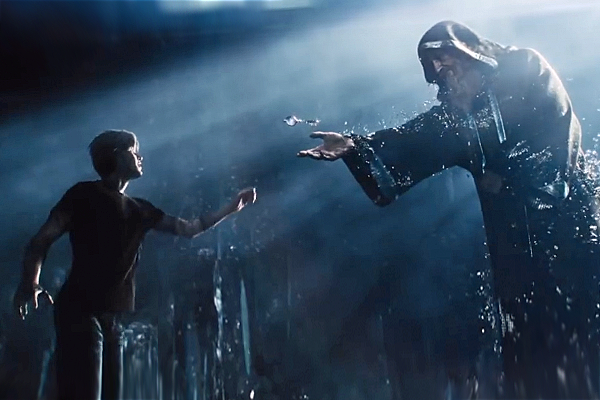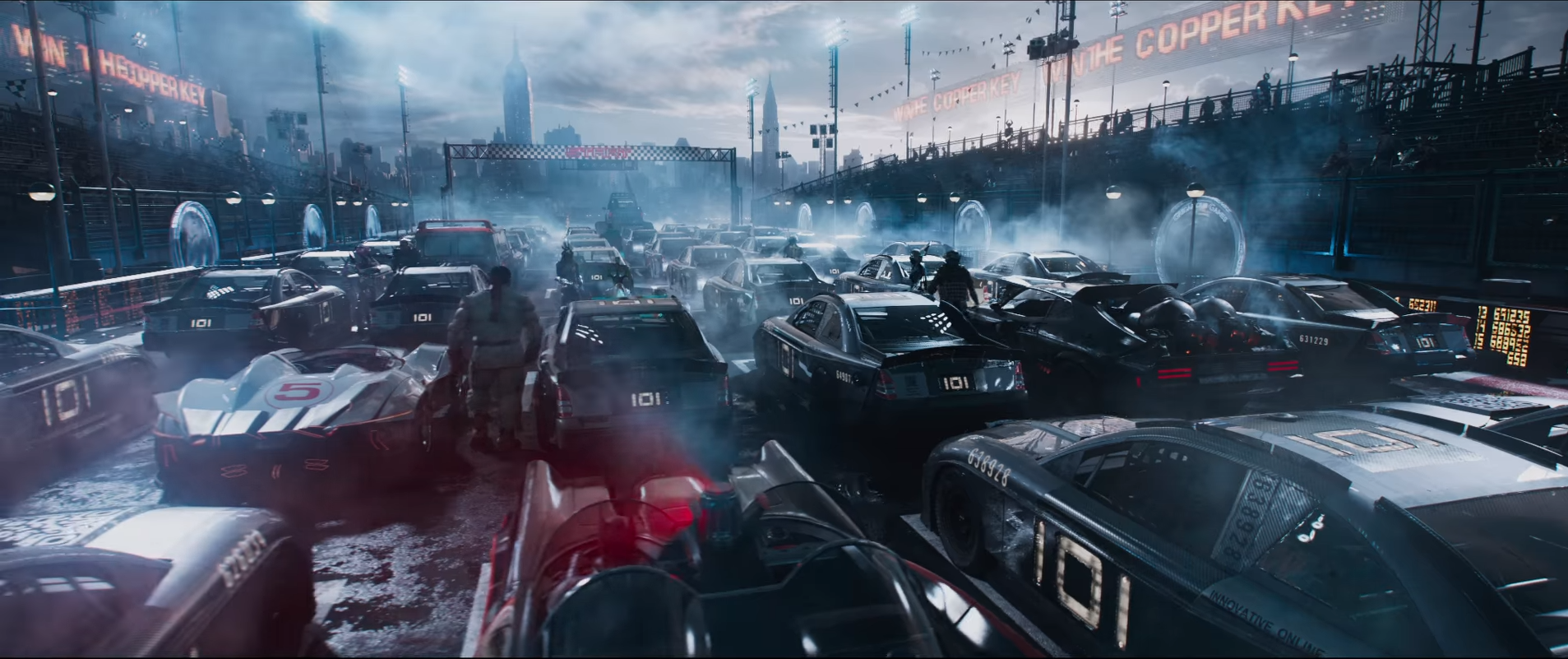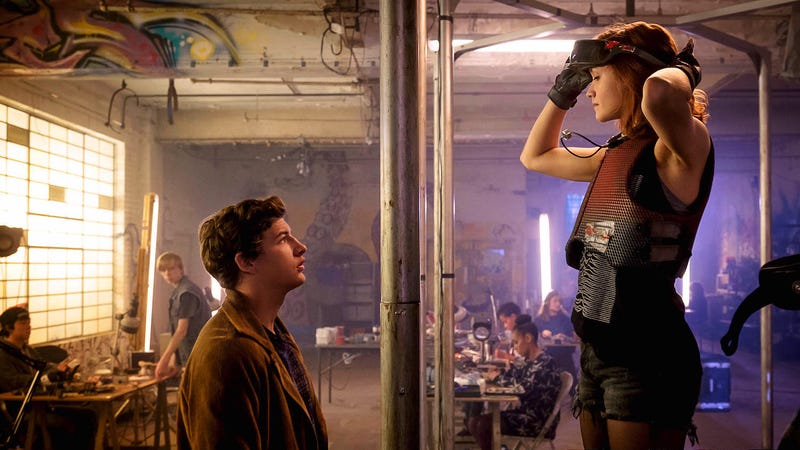Steven Spielberg’s adaptation of Ernest Cline’s Ready Player One is action packed and loaded with Easter Eggs just in time for the Easter Season. With visual references galore in homage to geek culture and fandoms of the 1980’s – it’s nothing short of eye candy; visually stunning through and through.
Ready Player One is a science-fiction adventure film set in the year 2045. Humanity is suffering, and so to escape from it, many dive deep into the virtual reality world known as the Oasis. In the Oasis anything is possible. There’s a world for every game, pleasure, and indulgence the brain can feasibly process. You can do anything in the Oasis VR.
The creator, an oddball known as James Halliday, has recently died. In his will, he has decided to run a contest similar in style to Willy Wonka’s golden ticket. Those that can find his Easter Egg in the Oasis will gain full control of the Oasis itself and his company – including Halliday’s vast fortune. Many have decided to take on the task of finding it including Wade Watts, aka Parzival, the story’s hero. In the way of Wade and friends is an evil corporation run by Nolan Sorrento, who wants to absorb the Oasis into their company be the one true ruler of the digital world!
The premise is more-or-less the same in the movie as it is in the novel. The problem arises in what gets lost in translation.
The original is focused on obsession and geek culture. Written with hardcore fandom in mind. It was meant to represent a specific audience. The kinds of people that check for set-piece accuracies of Star Wars movies, or debate for hours on a subreddit about what the true meaning of Lost was.
Parzival represented the geekiest of nerds. A man whose obsession over trivialities and pop-culture would one day lead to the grand prize. This was a love story about those obsessed with the little things that didn’t matter and it felt good to be represented (speaking for myself, included).
Ready Player One the movie is just not that. It tries in ways but falls short in capturing that story. I understand how as a film, cuts needed to be made. Studios had to get approval for copyrights and that movie making is ugly business in that it never turns out as expected. But as the evident divide between book and movie fans show – the hardcore fans were not happy about losing their story.
That said, it’s still a decent movie and I’ll cover what it does well toward the end.
I just think it could have been much more.
*The following contains spoilers to Ready Player One – though none if you read the novel*
How the Book and Movie Differ
Ready Player One was an entertaining joy ride that followed many beats of the original story: the virtual reality where anything was possible, the Willy Wonka type promise of the chocolate factory (In this case, control of the Oasis), the hunt for Halliday’s Easter Egg (the quest), and the race against the clock versus IOI, aka the corporate villains – are all present and somewhat faithful to the novel.
This makes sense as Ernest Cline, author of Ready Player One, teamed up with renown superhero movie writer, Zac Penn in writing the adaptation. Penn is most known for his X2 and Avengers screenplay fame.
Although Cline wrote the initial draft, he found difficulty in keeping the original story intact due to various titles of licensed property usage and shifting into a more fast-paced movie format. What results is a story that moves forward quicker, yet the stakes are nowhere nearly as high. The movie is less dramatic than the novel, with elements of the world being completely removed such as the school setting and all the D&D references (a popular game for the 1980’s, which is part of that 80’s lore).
Much of how the Oasis effects everyday living is also explained mostly through exposition, conveniently placed conversations, and the settings, such as The Stacks, being shown on screen.
There’s a general rule in filmmaking 101: Show, don’t tell. Ready Player one does a good job of showing without explaining significance. Saturating the screen with pop culture references but not providing context to its relevance.
Surprising, given that Steven Spielberg has made a career out of book adaptations.

Likewise, the movie tries hard in being all-inclusive and child friendly. This forces many changes. You’ll notice immediately that the entire first act/key quest was changed into a something more visually compelling for the sake of shortening the narrative. While the race is faster and introduces us to all the active players much easier, it comes at a huge cost to character development. The movie losing a chunk of its heart right from the opening act. This was the first of many sins I thought about the movie regarding characterization.
Characters You Can Count On?

There’s a lot wrong here in the characterization. Though I will admit, movies, because they’re very succinct, are more about style and visuals. A lot needs to happen in a short run-time. TV, with a lot more room to work with, is usually better for character development because there is more time to fill with side plots and story objectives – moments of understanding that can layer characters.
Unfortunately, the movie does a very rushed job that cuts so much from the original story.
Here are a few big ones:
We don’t get to intricately see Aech and Parzival hanging out and being best bros. We see moments, but nothing that shows their bickering, trolling each other, or bro-like competition with one another. In fact, the entire reveal of Aech’s backstory seemed more like an afterthought. Between casting reveals and a very poor choice in using voice modulation, they really didn’t try making it as big of a hook as it was in the books. Aech’s reveal is supposed to be mind-blowing. It really made me rethink gender roles and the nature of my own friendships. In the movie, it was given away early, very much at their first interactions.
We also don’t see the subtle development of Parzival and Art3mis’ partnership overtime. Instead, we’re force fed a romance from the beginning. Following this unrealistic Hollywood trend of Boy meets Girl and wins girl by finishing a quest. For a movie trying so hard to attract a young audience, it’s still not breaking the conventional Hollywood stereotypes.
In the books we see Parzival and Art3mis being Gunters, using their heads to follow clues and have slightly flirtatious yet compelling exchanges over time. It’s in this slow reveal that they acknowledge their similarities in personality. Which then leads to more, including their budding romance.
However, I will admit that the movie does a much better job of giving Art3mis a fully rounded personality and her own objectives to accomplish. More on that later.
Though the biggest sin in my opinion, was the mystery behind Daito and Shoto (Two big fan favorites). In the books, the pair are more of the mysterious ninja types; embracing honor, representing their cultural heritage, and above all else, being amazing kickass Gunters despite little to nothing being known about them. Likewise, the reveals of their identities in the book are equally as compelling as Aech’s yet meant such little significance in the movie.
Then, there is Daito’s last stand. A fan favorite scene and I’ll argue one of the most beautiful moments of the story. During it, Daito transforms into the legendary Japanese Tokusatsu, Ultraman to hold off a large sixer gunship army and give Shoto a surviving chance to escape on the Bebop (from the anime Cowboy Bebop) with the Jade Key. Everything was going well until IOI, in real life, took the incredibly troublesome Daito and threw him off a balcony – killing both him and his taking heavy fire avatar in the process.
The moment was a fan service done for Anime and Asian culture but mostly was significant because it represented the moment where the stakes became all too real. The players, had to grow up and realize just how serious this task was.
This scene was completely cut from the movie.
Why? Because let’s be honest… an evil corporation murdering a child doesn’t really sit well in selling a PG-13 movie.
Though the oddest cuts from the movie were the Halliday and Ogden Morrow storyline. Very little of it is left in the film and we don’t get anywhere near the sense of mentorship that is in the books.
In fact, if I hadn’t read the book, I’d think the founders were creepy. Morrow, played by the wonderful yet underused Simon Pegg, is barely in the movie. When you put it into full context, he’s also been sort of stalking the teenagers a large chunk of the time. Similarly, Halliday’s awkwardness is so overblown that it seems like he can’t engage in the most basic of interactions. With all the intricate moments removed in the movie between Parzival and Anorak, his God-like D&D and Oasis avatar, there’s just so much less to sympathize with in Halliday’s story. Which makes little sense given that the world is build around this man’s personality and larger-than-life dream.
Oh, and on a final note, T.J. Miller as i-R0k is completely unnecessary. Given the removal of the school in the story – it made little sense why this character was in the movie. It’s obvious they put him in as a daunting comedic villain. With Miller saying in interviews, he was supposed to be IOI’s personal Boba Fett. To me, he seemed more like their Jar-Jar Binks. Trying too hard for the lowest bits of comedy.
What Could Have Been Better.

Two major elements were cut from the book that would’ve helped. The first, is Anorak’s Almanac, Halliday’s personal detailed life journal. The movie tries to go around this by utilizing a library archive of all Oasis knowledge yet in doing so, belittles the importance of the Almanac in the first place.
Halliday is a man who had a difficult time with friends. His journals, his quest, was in many ways a form of connecting with people in a way that he couldn’t in life. Taking the Almanac out ruins a large point of the story: The idea of idolatry and nerdish obsession. It’s still in the movie but it’s nowhere near as detailed or as prevalent and it almost defeats the purpose of the world building.
The second cut, was the explanation for the need of 1980’s pop-culture obsession. This is explained through the roles of Gunters: participants in Halliday’s Easter Egg challenge. Their mission is to find the three keys using their knowledge of Halliday and the 1980s. Originally, the high five are all Gunters.
Again, these all tie together with the book’s themes of nerdish obsession, idolatry, and the of course, the story’s biggest lesson: how to let that go and start living in the real world.
Unfortunately, in the book this is symbolized by Wade finally pursing a relationship with Samantha, aka Art3mis. In this case, winning the girl meant the embodiment of becoming a ‘real’ person and essentially, growing up – the lady, being the reward.
Thankfully, the movie knew that this theme didn’t really sit well in modern pop-culture. Women are much more active players in contemporary storytelling, and so they gave Ar3mis a lot more to do. In this case, giving her Wade’s entire infiltration story arc.
And it worked.
What The Movie Does Right
While the 1980’s tropes are still there, it’s used more as background noise accentuating the conflict. In the books, it’s more for world building and puzzle solving. I understand. Nobody wants to watch Wade play a dozen levels of Pac-Man or recite lines from John Hughes movies by memory. In fact, some critics praised cuts to the overemphasized 80’s nostalgia saying it helped speed the plot along. Which is true.
But speaking for the book nerds – I really loved this story for its obsessions. I missed the moments of contemplation and 1980’s references. Though I understand, that’s not this movie.

Instead, in the film you get the high five from the get-go, you get the quest, and you embark on the journey. Pedal to the metal style. Literally, as we get things going with a racing scene of Mario Kart meets Twisted Metal, proportion for quest one.
In the same token, although cuts were made to almost all the high five’s storylines, Art3mis is a much more developed character. She infiltrates IOI in a much more believable and entertaining way than Wade does in the books. She also has a deeper personality as a key influencer in the rebellion.

The movie also makes the conflict more visible. Explaining a LOT about why IOI is bad: by making them your prototypical bad-guy corporation. By conveniently emphasizing indentured servitude and adding a rebellion story to REALLY draw the lines of good versus evil. Though it lacks subtly, it gets the point across quickly.
It just lacks the depth of its villainy. The complexities of corporations. How dependent society has become on a system created by one man.
Whose only dream was a free internet… er… I mean, Oasis.

Anyway, instead of a story about nerd lingo, geeky nerd debates, and D&D campaigning you get a bombastic Steven Spielberg action movie featuring kids in a violent videogame.
The movie’s style very much his modus operandi. Spielberg began his career trying to attract younger audiences to his movies. Ready Player One, panders towards youth – with videogames and pop-culture references aplenty. Spielberg had also secured rights for many trademarked characters – mostly because it was his big name attached to the project. If it wasn’t for him, Ready Player One would’ve been a nightmare to approve licensing for.
That said, the movie is loaded with Easter Eggs filled with (pre-approved) pop-culture references, 138 of them in fact. All engaging and fun to look out for to say the least.
So the movie, for all intents and purposes, is at least a fun joyride.
Final Thoughts
/cdn.vox-cdn.com/uploads/chorus_image/image/59124873/RPO_TRLR_0173.0.jpg)
My issue with Spielberg’s direction is that you can tell it’s his movie. The book’s trademark style is missing on the big screen. That is to say, for a story about nerdish obsession over the 1980s and arcade style videogames, none of this seems organically present.
At best, these moments act more like a check mark to showcase that the movie did its research and forced in the scene. There’s just too many awkward moments with the pacing. With Halliday’s story, Wade’s rushed exposition, and the Sam and Wade romance story.
This is in my opinion was a big problem with Ready Player One. For the novel fanatics such as myself, I really wanted to see the D&D references, Obsessions of the Gunters’ with Anorak’s Almanac, and see some epic arcade style duels of Pac-man and Joust. None of that is in the movie much to my, and many fanboys like myself, dismay.
What results, is a lot of shortcutting for sake of runtime convenience at the cost of characterization and world development. But hey, we get a whole lot of nerdy eye candy.
